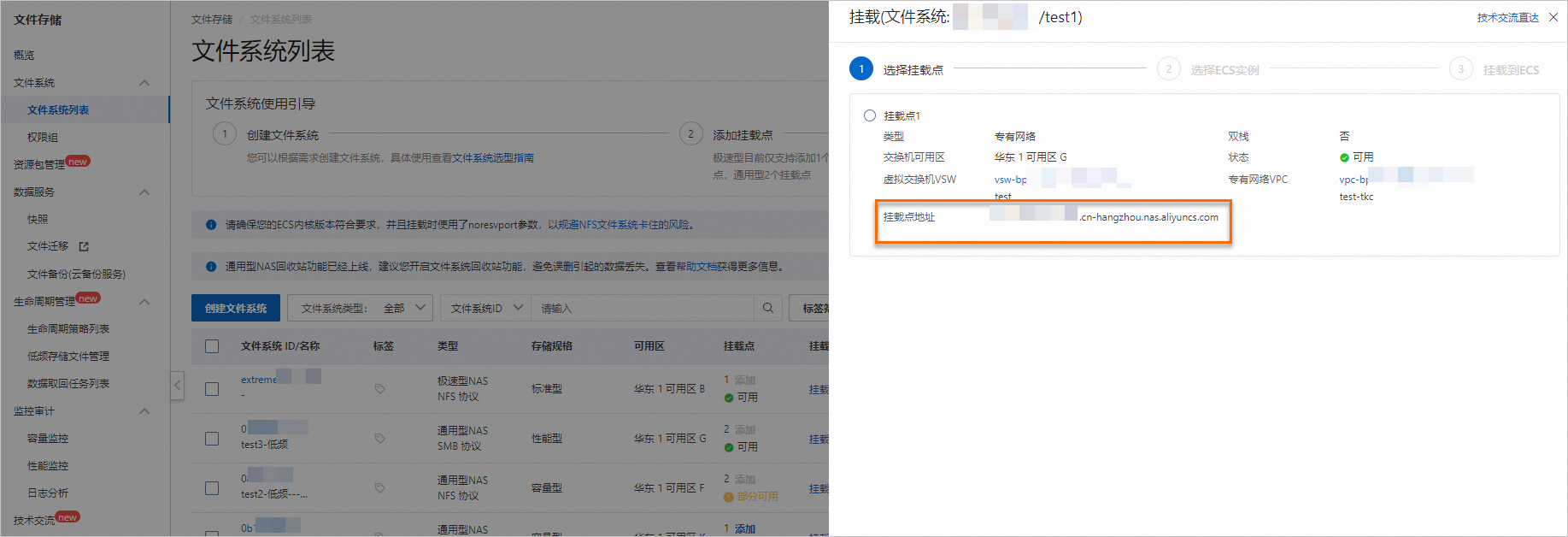本文介紹如何在NAS控制台上進行掛載點的管理,包括掛載點的添加、查看、修改及刪除操作,以實現對NAS檔案系統的高效訪問與管理。
前提條件
已建立檔案系統。具體操作,請參見建立檔案系統。
使用限制
如果掛載點數量未能滿足您的業務需求,請提交工單申請。
通用型NAS檔案系統
支援添加兩個掛載點。
自2022年11月21日起,通用型NAS檔案系統不支援建立傳統網路類型的掛載點。2022年11月21日前建立的傳統網路類型掛載點仍可正常掛載訪問檔案系統。
極速型NAS檔案系統
2024年1月19日前建立的檔案系統:僅支援添加一個掛載點。
2024年1月19日起建立的檔案系統:支援添加兩個掛載點。
添加掛載點
在Apsara File Storage NAS中,需要通過掛載點將檔案系統掛載至Elastic Compute Service,添加掛載點的操作如下。
登入NAS控制台。
在左側導覽列,選擇檔案系統>檔案系統列表。
在頁面左側頂部,選擇目標檔案系統所在的資源群組和地區。

在目標檔案系統的操作列,單擊添加掛載點。
在添加掛載點對話方塊中,配置如下參數。
一個專用網路類型掛載點可以被同VPC下的不同交換器下的ECS執行個體使用。
添加掛載點時,檔案系統會佔用一個IP地址,建議您選擇內網IP較多的交換器。
IPv6功能僅支援極速型NAS,且部分地區已具備此功能。在開啟IPv6功能前,您還需要為目標檔案系統搭建IPv6專用網路。具體操作,請參見搭建IPv6專用網路。
參數
說明
參數
說明
VPC網路
選擇已建立的VPC網路。如果還未建立,請前往VPC控制台建立。
必須與Elastic Compute Service選擇一樣的VPC網路。如果是不同的VPC,則需要先通過雲企業網連通網路,才能掛載檔案系統。更多資訊,請參見通過雲企業網實現同地區跨VPC掛載NAS。
交換器
選擇VPC網路下建立的交換器。
許可權組
根據需求選擇許可權組。
初始情況下,每個帳號都會自動產生一個VPC預設許可權組,允許同一VPC網路下的任何IP地址通過該掛載點訪問檔案系統。您也可以根據業務情境建立許可權組。具體操作,請參見操作步驟。
開啟IPv6
開啟IPv6功能。
極速型NAS在支援IPv6的地區內,且VPC網路和交換器符合IPv6規則時,開啟IPv6開關生效。關於搭建IPv6專用網路的具體操作,請參見搭建IPv6專用網路。
配置完成後,單擊確定。
開放連接埠
掛載點建立完成後,將開放如下連接埠用於訪問NFS服務和SMB服務:
儲存類型 | SMB服務連接埠 | NFS服務連接埠 | 協議類型 |
儲存類型 | SMB服務連接埠 | NFS服務連接埠 | 協議類型 |
通用型NAS檔案系統 | 445:用於訪問SMB服務。 |
| TCP協議。 |
極速型NAS檔案系統 | 不支援。 |
查看掛載點資訊
查看掛載點列表
登入NAS控制台。
在左側導覽列,選擇檔案系統>檔案系統列表。
在頁面左側頂部,選擇目標檔案系統所在的資源群組和地區。

在檔案系統列表頁面,找到目標檔案系統,單擊管理,在檔案系統詳情頁面,單擊左側掛載使用,在掛載點地區,查看掛載點列表。
查看掛載點地址
您可以通過以下兩種方式查看掛載點地址。
在檔案系統列表頁面查看
在檔案系統列表頁面,找到目標檔案系統,單擊操作列的掛載,即可查看到目標檔案系統的掛載點地址。

在檔案系統詳情頁面查看
在檔案系統列表頁面,找到目標檔案系統,單擊管理,在檔案系統詳情頁面,單擊掛載使用,在掛載點列表的掛載點地址列,將游標放置在
 表徵圖上,即可查看目標掛載點的掛載點地址。
表徵圖上,即可查看目標掛載點的掛載點地址。
查看已掛載的用戶端列表
NFS協議通用型NAS檔案系統支援在控制台上查看已掛載檔案系統的用戶端的IP地址。
登入NAS控制台。
在左側導覽列,選擇檔案系統>檔案系統列表。
在頁面左側頂部,選擇目標檔案系統所在的資源群組和地區。

單擊目標檔案系統,進入檔案系統詳情頁面。
單擊掛載使用,然後單擊掛載點列表操作列的,查看已通過該掛載點掛載NAS的用戶端的IP地址。
目前僅支援查詢近一分鐘內正在使用NAS的用戶端,部分已掛載而沒有使用的用戶端可能未顯示在此列表中。
查詢ECS執行個體掛載詳情
通過查詢功能,您可以查詢已掛載NAS NFS協議檔案系統的ECS的ECS執行個體基礎資訊和掛載資訊,包括ECS ID、IP地址、掛載路徑、NAS目錄及掛載協議類型等資訊。
登入NAS控制台。
在左側導覽列,選擇檔案系統>檔案系統列表。
在頁面左側頂部,選擇目標檔案系統所在的資源群組和地區。

單擊目標檔案系統,進入檔案系統詳情頁面。
單擊掛載使用,選擇掛載點頁簽,然後單擊目標掛載點操作列的掛載。
在掛載面板,單擊目標ECS執行個體操作列的查詢掛載詳情,查看ECS執行個體的基礎資訊及掛載路徑、NAS目錄等。

修改掛載點資訊
修改掛載點許可權組
禁用和啟用掛載點
通用型NAS支援禁用和啟用掛載點,控制用戶端對掛載點的訪問。
登入NAS控制台。
在左側導覽列,選擇檔案系統>檔案系統列表。
在頁面左側頂部,選擇目標檔案系統所在的資源群組和地區。

單擊目標檔案系統,進入檔案系統詳情頁面。
在掛載使用頁面,選擇掛載點頁簽,然後單擊掛載點列表操作列的
 表徵圖,禁用或者啟用。
表徵圖,禁用或者啟用。禁用:暫時阻止任何用戶端對該掛載點的訪問。
啟用:重新允許用戶端對掛載點的訪問。
休眠掛載點
通用型NAS支援空閑掛載點休眠功能,儲存量為0且近2個月無任何訪問的掛載點連結將自動進入睡眠模式,並釋放資源佔用。進入睡眠模式後,無法再掛載訪問。您可以參照以下步驟啟用休眠的掛載點。
暫不支援華南1金融雲地區,其餘地區均支援。
登入NAS控制台。
在左側導覽列,選擇檔案系統>檔案系統列表。
在頁面左側頂部,選擇目標檔案系統所在的資源群組和地區。

單擊目標檔案系統,進入檔案系統詳情頁面。
單擊掛載使用,選擇掛載點頁簽,然後單擊目標掛載點操作列的,重新啟用掛載點,啟用成功後,才能正常掛載訪問。
刪除掛載點
刪除掛載點後,無法恢複,請謹慎操作。
未卸載掛載檔案系統就刪除掛載點,可能會導致伺服器執行命令無響應。如果您不需要使用該掛載點掛載訪問檔案系統,建議您先卸載掛載的檔案系統,然後再刪除掛載點。
如需刪除由阿里雲內部服務添加的掛載點,請務必謹慎操作。例如,刪除Cloud Shell、雲備份及Machine Learning Platform for AI服務的掛載點,可能會對服務的正常使用產生影響。
登入NAS控制台。
在左側導覽列,選擇檔案系統>檔案系統列表。
在頁面左側頂部,選擇目標檔案系統所在的資源群組和地區。

單擊目標檔案系統,進入檔案系統詳情頁面。
在掛載使用頁面,選擇掛載點頁簽,然後在掛載點列表的操作列,單擊,刪除掛載點。
後續操作
如果您添加掛載點後需要對NA進行網路連通性檢查,請參見網路連通性檢查。
如果您添加掛載點後需要NAS掛載,請根據實際情境進行掛載操作。更多掛載方式,請參見掛載情境。
如果您刪除NAS掛載點後,需要停止NAS計費,請參見如何關閉NAS服務或停止計費。
如果您查看已掛載的用戶端列表後,需要進行NAS的卸載操作,請參見通過NAS控制台卸載掛載目錄。
如果您的掛載點為傳統網路,並且需要切換至Virtual Private Cloud,請參見Apsara File Storage NAS執行個體從傳統網路掛載點切換為VPC掛載點。
常見問題
如果您對掛載點的概念不瞭解,請參見掛載點是什嗎?有什麼作用?
如果您需要修改載點的網路類型,請參見掛載點是否可以轉換網路類型?
如果您需要更換掛載點的VPC網路,請參見NAS能否切換VPC?
如果您在添加掛載點時無法建立傳統網路的掛載點,請參見為什麼無法建立傳統網路類型掛載點?
如果您在添加掛載點後遇到NAS掛載相關問題,請參見掛載檔案系統失敗故障排查。
有關管理檔案系統、掛載點及許可權組的更多問題,請參見基礎管理FAQ。
 表徵圖 > 已掛載客戶端
表徵圖 > 已掛載客戶端